Exactly 125 years ago, on 25 September 1897, Franz Joseph ordered the erection of ten public statues in Budapest that commemorate the great figures of Hungarian history in his letter addressed to the then Prime Minister, Baron Dezső Bánffy. He put it like this: "the suitable spaces of my Hungarian capital city should be equipped with smaller sculptures, which, while they decorate the city, at the same time perpetuate the memory of the outstanding figures of the past, who distinguished themselves in various fields of national life". The provision also included that the costs should be covered by the royal court maintenance budget.
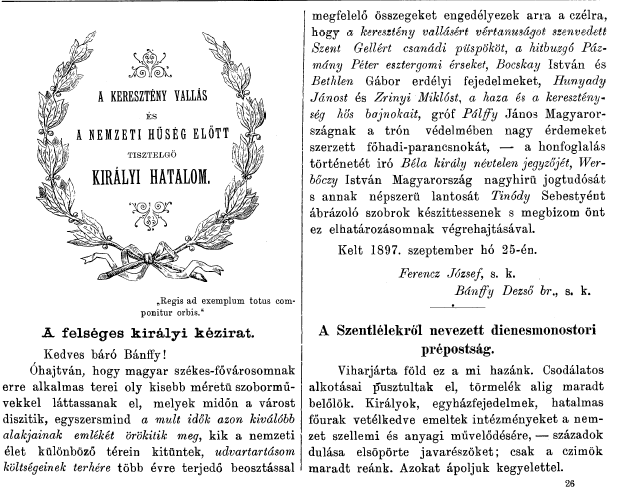
Almost all the newspapers wrote about the royal decision (Source: Religio, 29 September 1897)
In the text, the ten outstanding persons were also named by the ruler, the list was as follows in the order given by the king: St, Gerard, Péter Pázmány, István Bocskai, Gábor Bethlen, János Hunyadi, Miklós Zrínyi, János Pálffy, Anonymus, István Werbőczy and Sebestyén Tinódi Lantos. The king allocated 400,000 crowns for the erection of the statues, but in the end, Franz Joseph's gift cost half a million crowns.
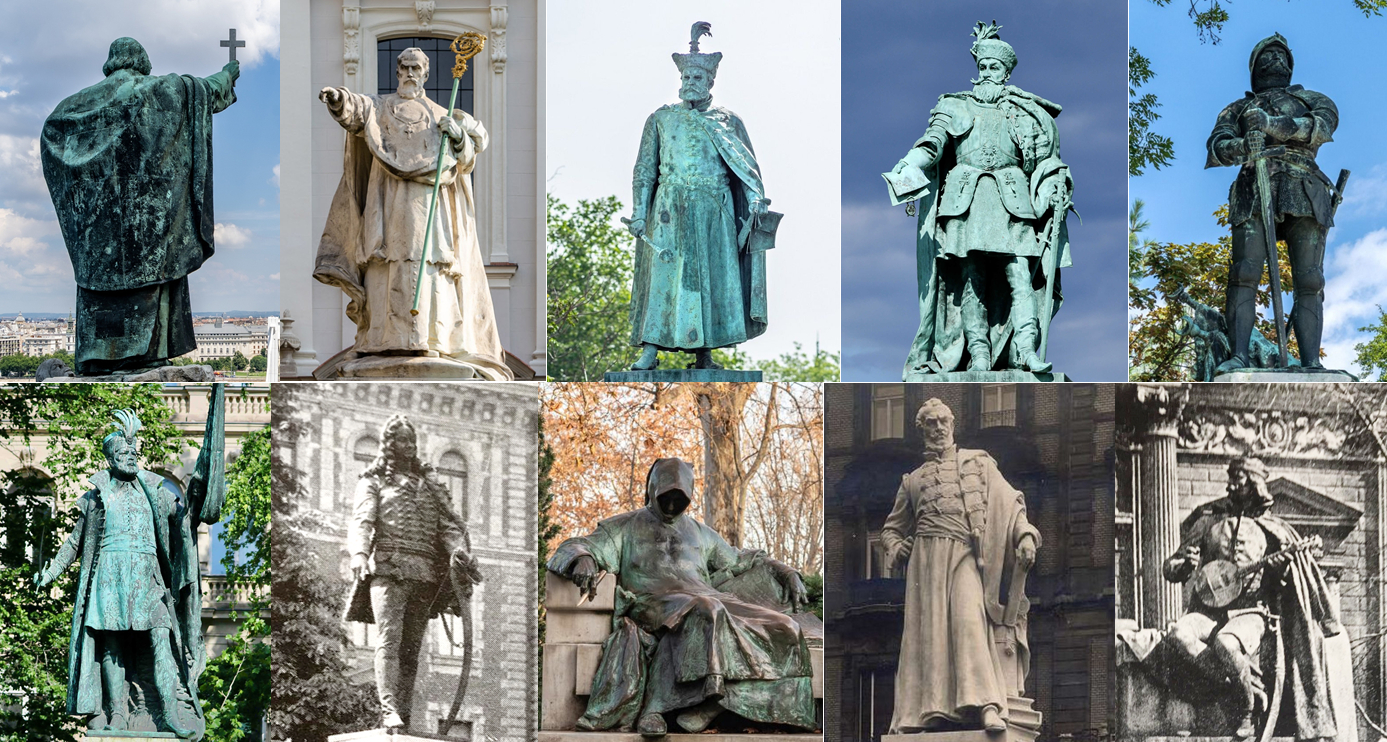
The list is in the order given by the king
The decision to erect the statue was considered a huge event, almost every newspaper reported on it the next day. In the evening, university youth and citizens organised a torchlight procession in honour of the king. Mayor József Márkus distributed two thousand torches for this occasion. Pesti Hírlap put it this way in its issue of 26 September 1897: "In any case, the news of the king's gift spread throughout the country, giving much work to telegraph offices and telephones. Even in the larger rural towns, where the newspaper service is good, the papers were published in special editions, literally publishing the royal manuscript, which made today a happy day for beautiful Hungary."
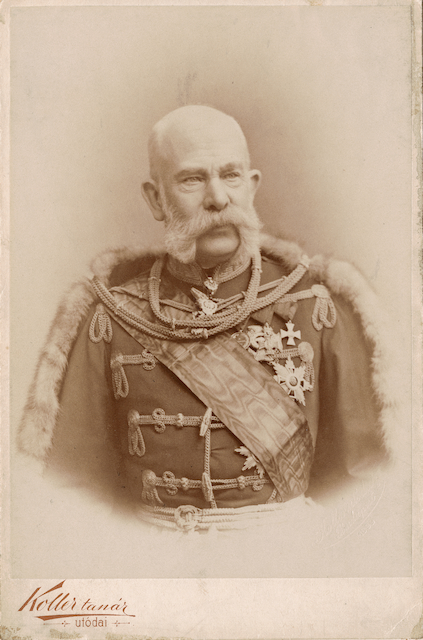
Franz Joseph's photo from the 1890s (Source: Hungarian National Museum Historical Photograph Collection)
Budapesti Hírlap put it even more pathetically in its issue of 26 September: "After a quarter-and-a-half century of stumbling along different paths: the nation and the king found each other and got to know each other. Today marks a turning point in our history. Today, the Habsburg dynasty truly becomes our national dynasty. The words of the soothsayer Kölcsey were dressed in the garb of reality: This nation has suffered for all sins: Of the past and the future. [These are lines from the Hungarian National Anthem, the Himnusz by Ferenc Kölcsey] Thanks to the good, noble, great king and thanks to our gracious providence!"
The sculptures were completed over several years, which we will report on later, but what is more interesting is why they were given as gifts. According to the best-known legend, Emperor Wilhelm II, who was visiting Budapest in September 1897, told Franz Joseph that he thinks there are too few statues in the city. However, this was not written in the newspapers at the time. The first important source that referred to Emperor Wilhelm was Endre Liber's 1934 volume entitled Budapest szobrai és emléktáblái [Statues and memorials of Budapest]. In it, the author wrote: "When the German Emperor Wilhelm II was in Budapest in 1897, after a carriage ride, according to tradition, he highly praised the beauties of our capital, but said that he was not satisfied with our statues, especially because he saw very few statues. He marvelled at this, mostly because, so to speak, the history of Hungarians is full of Heroes who deserve to have their memory cast in bronze or carved in stone to proclaim their greatness. Emperor Wilhelm allegedly did not hide his opinion about the capital's statues even from his majestic friend, King Franz Joseph I."

Entry of the German Emperor Wilhelm II into Budapest (Source: Ország-Világ, 26 September 1897)

Emperor Wilhelm II in the court box of the opera performance in Budapest (Source: Vasárnapi Ujság, 3 October 1897)
The text reveals that, according to Endre Liber, who wrote a book about the capital's sculptures and was the mayor of Budapest at the time of writing the book, one can only rely on "tradition", we have no certain information about what antecedents contributed to Franz Joseph's decision on 25 September 1897, to order the erection of the mentioned ten statues.
What is certain, however, is that almost all newspapers and news reports about it refer to the toast given by Emperor Wilhelm II during his stay here in September 1897, when the question of why Franz Joseph was so generous is discussed. Liber also highlights this in his work: "In his famous toast, in which he glorified our national heroes, he specifically mentioned Zrínyi's name, with the most exalting words."
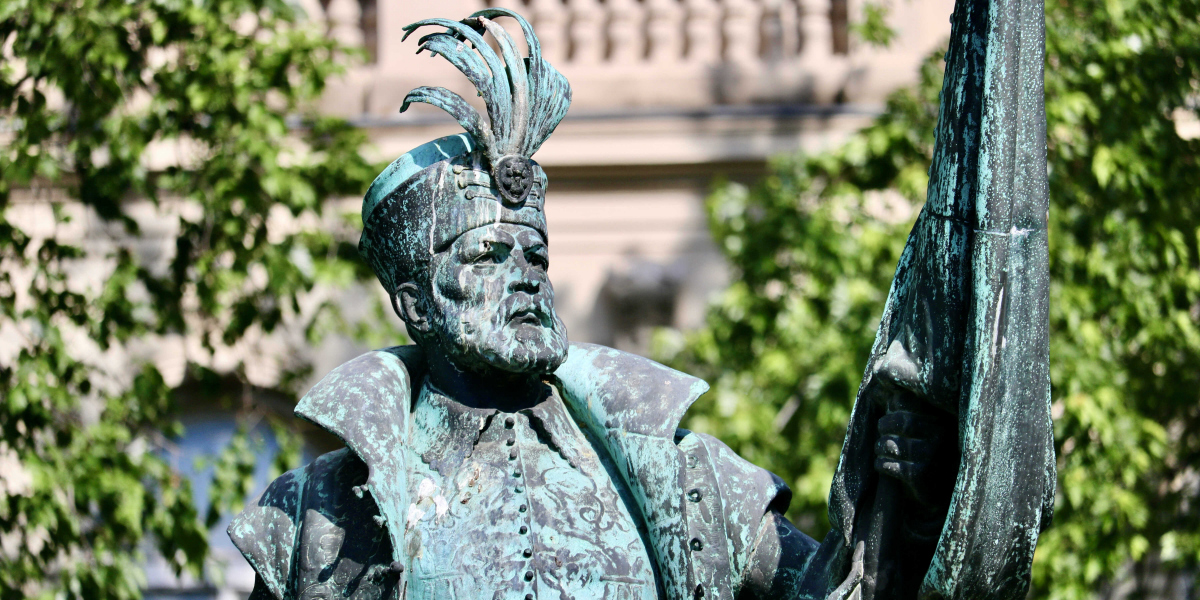
Miklós Zrínyi's statue on Kodály Körönd (Photo: Júlia Kozics/pestbuda.hu)
The papers wrote that in addition to mentioning the heroic deeds of Zrínyi, Wilhelm II also noted that Hungary was so often the bastion of Christianity, so many times it was necessary to protect the faith and the country from different peoples. And if you look, most of the statues are really related to the defence of Christianity, some in this way, some in that way.
The school bulletins of the time also reported on Wilhelm's visit. The 1897 bulletin of the Székesfehérvár Civic Girls' School wrote about the story as follows: "The toast of the German emperor, which can be safely called a historical retrospective, mentions with the greatest praise the loyalty and loyalty of the chivalrous Hungarian nation to the throne and crown. Wilhelm II said with all the heat of his world of emotions that Szigetvár and Zrínyi ignite the flaming patriotism of the German and Prussian student youth [...] Imperial lips finally sang a hymn of praise to the paternal friend, our king, who has such outstanding and unfailing merits in the maintenance of European peace. – The German Emperor Wilhelm II's toast in the Buda Castle was, so to speak, covered by the press of the whole world, and this toast resulted in the attention of the entire continent being directed towards us and the Austrian predominance shifted to Hungary."

Statue of János Hunyadi under the Fisherman's Bastion, on Hunyadi János Road in the 1st District (Photo: Balázs Both/pestbuda.hu)
Reading the accounts of Emperor Wilhelm's visit in September 1897, it cannot be ruled out that Franz Joseph really took measures to erect the statues so quickly - in the same month - because Wilhelm II spoke highly of Hungarian heroes on several occasions, naming several of them, including Zrínyi, and extolled the deeds of people who had no public statues in Budapest until then.
This idea is also supported by the fact that, although the ten statues were erected in the capital's public areas over many years, the first work, which was already completed in 1899, was the statue of Miklós Zrínyi, and the statue committee saw it even that year in the studio of József Róna. The bronze casting was completed in May 1902, after which the work was placed on the Kodály Körönd.
The creators of the ten statues of the gift, the time of their unveiling and their current location:
Statue of St. Gerard (1902), artist: Gyula Jankovits, location: the slope of Gellért Hill
Statue of Péter Pázmány (1914), artist: Béla Radnai, location: Originally, the statue stood on the small opening of the northern Klotild Palace towards Ferenciek Square (5th District, 11 Kígyó Street) In 1958, it was moved in front of the Józsefváros Parish Church
Statue of István Bocskay (1903), artist: Barnabás Holló, location: Originally it was on Kodály Körönd, then in 1958 it was moved to Heroes' Square
Statue of Gábor Bethlen (1902), artist: György Vastagh jr., location: It was originally on Kodály Körönd, then moved to Heroes' Square in 1948
Statue of János Hunyadi (1903), artist: István Tóth, location: It stands under the Fisherman's Bastion, at the bend of Hunyadi János Road
Statue of Miklós Zrínyi (1902), artist: József Róna, location: Kodály Körönd
Statue of János Pálffy (1905), creator: Károly Senyei, location: It was originally on the Kodály Körönd, then it was demolished in 1950. It is currently located in the area behind the A FÖRI Police Centre building (16th District, 27 Pálya Street)
Statue of Anonymus (1903), artist: Miklós Ligeti, location: City Park, near Vajdahunyad Castle
Statue of István Werbőczy (1908), artist: Gyula Donáth, location: Originally it stood on the Curia side of the Klotild Palace, but in May 1945 it was pulled down and the statue disappeared
Sebestyén Tinódy's statue (1907), artist: Gyula Bezerédi, location: It originally stood in front of the former National Theatre on Blaha Lujza Square, then in 1955 it was moved to Népliget
The reason for the king's gift is perhaps not so important for posterity. What is much more important is that the ten statues increased the light of Budapest even more through the generous donation and are still increasing it today.
Cover photo: The ten statues in the order given by the king

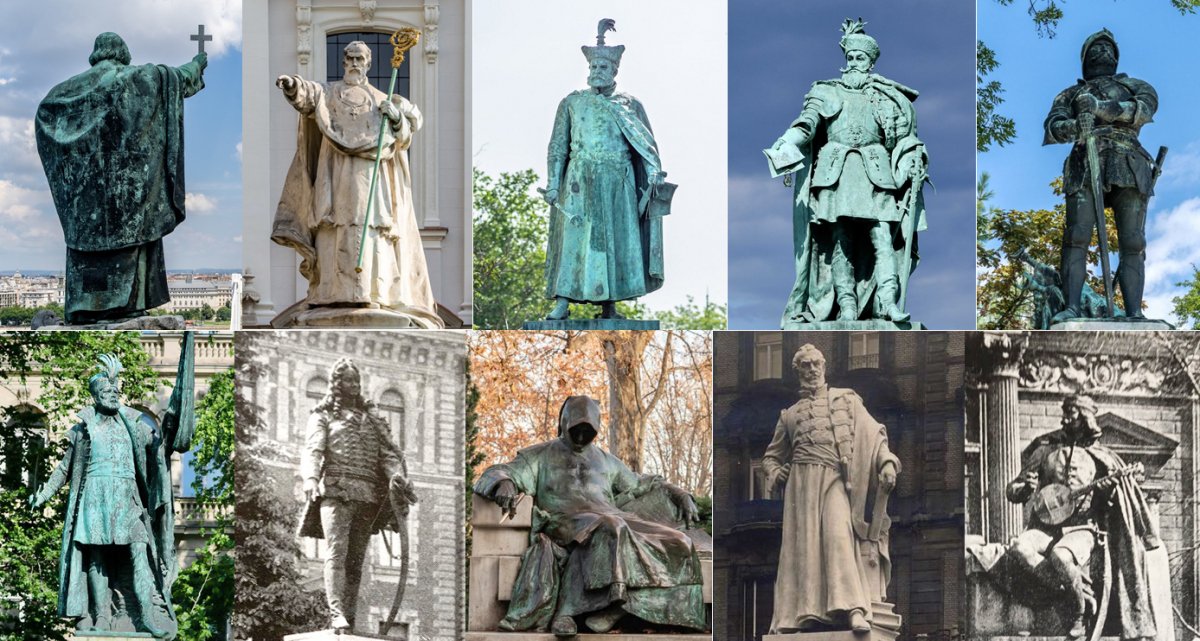


































Hozzászólások
Log in or register to comment!
Login Registration